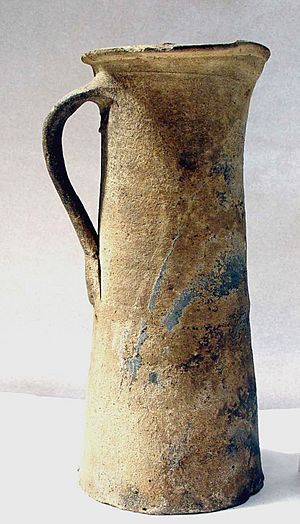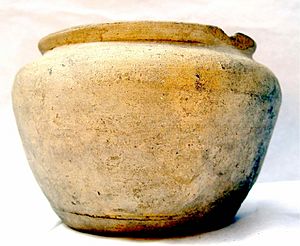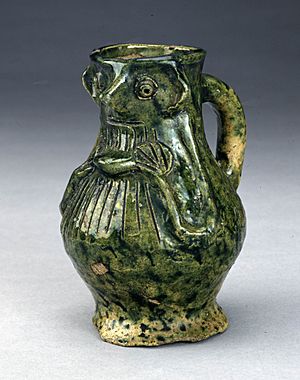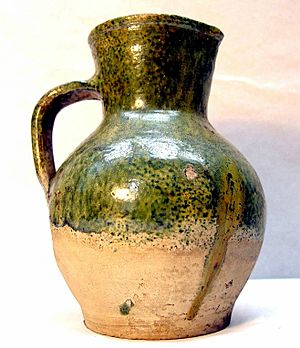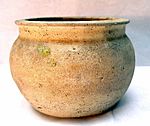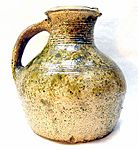Surrey whiteware facts for kids
Surrey whiteware is a special type of pottery made in Britain a long, long time ago, from the 1200s to the 1500s. It's called "whiteware" because it was made from a clay that turned white when it was fired (baked in a hot oven). This pottery was mostly made in places called Surrey and near the border between Surrey and Hampshire.
During the Middle Ages, Surrey whiteware was the most common type of pottery used in London. There are four main kinds of Surrey whiteware:
- Kingston-type ware
- Coarse Border ware
- Cheam whiteware
- Tudor Green ware
Contents
History of Surrey Whiteware
Surrey whiteware was very popular in London during the late medieval period. It was made in many kilns (special ovens for pottery) located in Surrey and along the Surrey-Hampshire border.
Archaeologists, who study old things, first identified three main types: Kingston-type ware, Coarse Border ware, and Cheam whiteware. Later, Tudor Green ware was added as a fourth, smaller type. Eventually, Surrey whitewares were grouped into two main categories: "Cheam whiteware" from Cheam, and "Coarse Border ware" from the Surrey-Hampshire border area.
The 1200s: Pottery Appears
Surrey whitewares first showed up in London around the mid-1200s. One type, called "Kingston-type ware," looked a lot like pottery made near Kingston upon Thames. This type, along with other local pottery, was used a lot in London from the late 1200s to the early 1300s.
Around the same time, small amounts of white, sandy jugs, cooking pots, and bowls also appeared. These green-glazed pots had a rough feel and looked like pottery made along the Surrey-Hampshire borders. This type was later named "Coarse Border ware."
The 1300s and 1400s: Pottery Changes
In the 1300s, people in London started wanting more Coarse Border ware, and less Kingston-type ware. By the early 1400s, Kingston-type ware was hardly used in London anymore. Coarse Border ware continued to be the most popular pottery from the mid-1300s to the mid-1400s.
"Cheam whiteware," named after the kilns in Cheam, first appeared in London in the late 1300s. It became more popular in London during the 1400s. Both Cheam whiteware and Coarse Border ware were the top choices for pottery in London during this century.
Tudor Green ware also started to appear in the late 1300s. By the early 1400s, it grew very popular and was even used more than Coarse Border ware and Cheam whiteware in London. However, by the end of the 1400s, people started to want less Cheam whiteware.
What Surrey Whiteware Looks Like
Surrey whiteware is made from white-firing clay mixed with fine sand. This gives it a sandy feel. All four types of Surrey whiteware (Kingston-type, Coarse Border, Cheam, and Tudor Green) have this similar sandy texture. "Tudor Green ware" specifically describes thin, green-glazed pottery made during the Tudor period.
Pottery Colors and Feel
The clay used for Surrey whiteware could be different shades, like buff, beige, off-white, cream, or pale grey.
- Kingston-type pottery felt hard and rough, but had a fine texture.
- Coarse Border ware also felt hard and rough, but its texture was uneven.
- Cheam whiteware felt similar to Kingston-type ware in how hard and textured it was.
- Tudor Green ware could be soft or hard, with a smooth feel and a fine texture.
Potters often put a clear or mottled (spotty) green glaze on their pots.
- On Kingston-type ware, the glaze often had tiny cracks (called crazing) and could be thin and uneven or thick and shiny. The color varied from green to dark green to brown.
- Coarse Border ware glaze also had crazing and a similar finish. Its color ranged from light to dark green and was sometimes mottled.
- Cheam whiteware glaze usually had crazing and could be thin or thick. Colors varied from yellow to light green to dark green.
- Tudor Green ware glazes were thick, even, and had crazing. They were typically different shades of mottled green.
Decorations on Pottery
Some Surrey whitewares were plain, while others had fancy decorations. Potters often used a clear or colored lead glaze. They also added decorations by:
- Coating pots with a white or red slip (a thin layer of liquid clay).
- Pressing stamps onto the clay.
- Making lines with a comb.
Stamped decorations were common on Kingston-type ware and Coarse Border ware, but not on Cheam whiteware. Sometimes, pots had two colors of glaze, like yellow inside and green outside. In the 1200s, it was popular to put glaze only on the top part of the pot. Simple painted designs or lines were also common.
Kingston-type ware had the most types of decoration, while Cheam whiteware had the fewest. Kingston-type ware often had combed or engraved lines. Fancier pots had a green glaze made with copper. Potters also added strips or bands of clay. More complex designs included stamped bumps, flower patterns, overlapping scales, and pinecone shapes. Sometimes, they even added human faces, though this was rare.
Coarse Border ware was mostly used by families for cooking. These pots were usually simple and plain. Besides green glaze, simple decorations included horizontal bands and engraved lines. Painted designs were sometimes used on large water containers called cisterns.
Cheam whiteware was mostly practical, used for storing and drinking liquids. Glaze was not always used on every part of the pot. Green or yellow glaze was usually put on the top half, and the inside of storage pots was often glazed. Simple painted or cut lines were common decorations.
There are fewer examples of Tudor Green ware because it was made with very thin clay. Tudor Green ware is famous for its beautiful green glaze.
Shapes of Pottery
Surrey whitewares were made in many common shapes from the medieval period. These included:
- Jugs
- Cooking pots
- Large deep bowls and pans
- Small bowls
- Dripping dishes (for catching fat)
- Lobed cups
- Chamber pots
- Money boxes
- Candlesticks
- Chafing dishes (for keeping food warm)
- Lids
- Pipkins (small cooking pots)
- Skillets (frying pans)
- Costrels (portable flasks)
- Storage jars
Large jugs with criss-cross engravings were a special type of Coarse Border ware popular in London from the late 1200s to early 1300s. Cooking pots and bowls were also very common forms of Coarse Border ware. From the 1300s to the mid-1400s, new types of plain pottery, often with simple grooved lines, were made for the London market.
Making and Selling Surrey Whiteware
Where the Clay Came From
The white-firing clay used for Surrey whitewares came from special clay beds called the "Reading Beds" in Surrey and near the borders of Hampshire and Berkshire. The best clay for potters making wares for London came from the Reading Beds between Farnham and Tongham. This area had been a great source of clay since the early Roman period. Other parts of the Reading Beds, extending to Guildford and Cheam, also provided good white-firing clay. Most pottery kilns were built close to these important clay sources.
How Pottery Was Made and Sold
Medieval pottery kilns were set up near where the raw clay was found. Farnham was a very busy center for the Surrey pottery industry. Kingston upon Thames was probably the first place to start making whitewares in the 1200s. Since Kingston upon Thames is far from the Reading Beds, the clay was likely brought there by wagons or by river. The potteries in Cheam and on the Surrey-Hampshire border were much closer to the clay sources.
Surrey whiteware was sold in a few ways. People could buy it directly from the places where it was made, or from markets in London and nearby areas. Pottery meant for London was probably first carried by wagons to the River Thames, and then transported by river into London. Cheam whiteware was mostly sold from its production sites or local markets.
From the late 1300s to early 1400s, Coarse Border ware was sold over a much wider area than the other types of Surrey whiteware. Besides London and its surroundings, it was traded along the River Thames, and even as far south as Winchester in Hampshire and into Berkshire.
Gallery
-
Tudor Green ware, money box
See also
- Stamford ware
- Border ware
- Sandy ware
- Humber ware
- List of English medieval pottery


